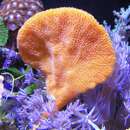Comprehensive Description
provided by Smithsonian Contributions to Zoology
Axinella polycapella de Laubenfels, 1953
Axinella polycapella de Laubenfels, 1953:530 [holotype, USNM 23405].—Hartman, 1955:177.—Wells and Wells in Wells et al., 1960:221 [USNM 23621].—Little, 1963:51.—Storr, 1964:5, 42; 1976:269 [distribution only].—Alvarez and Crisp, 1994:119 [cited only].
Axinella polypoides.—Schmidt, 1870:60 [BMNH 1939.2.10.29].—[not Schmidt, 1862:62; 1868:9; Donadey, 1990].
Axinella bookhouti Wells and Wells in Wells et al., 1960:219 [holotype, USNM 23659; new synonymy].
Axinella reticulata.—Wells and Wells in Wells et al., 1960:221 [USNM 23625].—[not Ridley and Dendy, 1886:481; 1887:184; Wilson, 1902:400 = Pseudaxinella reticulata].
Pseudaxinella wilsoni Wells and Wells in Wells et al., 1960:222 [holotype, USNM 23662; new synonymy].
MATERIAL EXAMINED.—Nontypes: Off South Carolina: USNM 42779 (32°49′42″N, 78°39′24″W, 33 m, coll. SCMR for MMS, 27 Feb 1981). Gulf of Mexico: USNM 34170 (22), USNM 39609 (1), USNM 39667 (6), USNM 41971 (42), USNM 42774 (2), USNM 42775 (17), USNM 42776 (36), USNM 42778 (39). Representative specimens from the same area in ZMA.
SHAPE (Figure 3a).—Erect and flexible branches, sometimes whip-like, on a central column of attachment; central column absent in small specimens. Total length up to 50 cm. Branches pointed, rounded, or dichotomous at tips, sometimes jointed. Star-shaped oscules, 2–5 mm in diameter.
SURFACE.—Smooth to velvet. Pierced by small pores less than 1 mm in diameter.
COLOR.—Live specimens reported as orange red or bright red (de Laubenfels, 1953). Purple, tan, dark brown, light brown, or combination of dark and light brown in alcohol.
SKELETON (Figure 3b,c).—Axial skeleton vaguely reticulated to condensed. Extra-axial skeleton plumoreticulated, becoming halichondroid near surface. Primary lines, connected by 1–3 spicules, ending at surface in brushes of spicules.
SPICULES (Figure 3d, Table 3).—Oxeas, usually bent; strongyloxeas and styles less common in most specimens.
DISTRIBUTION AND HABITAT.—Widely distributed in the Gulf of Mexico, on the Gulf and Atlantic coasts of Florida, and east coast of the United States from South Carolina to North Carolina. Occurs in rock patches or coral reef at depths of 13–44 m.
- bibliographic citation
- Alvarez, B., van Soest, Rob W. M., and Rützler, Klaus. 1998. "A Revision of the Axinellidae (Porifera: Demospongiae) of the Central-West Atlantic Region." Smithsonian Contributions to Zoology. 1-47. https://doi.org/10.5479/si.00810282.598

